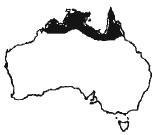Varanus Mertensi
Glauert 1951.Mertens' goanna, Bulliwallah.
 |
Mertens' goanna is rarely found more than a metre or so from water. They are frequently found in rocky gorges and have been recorded along slow and fast moving rivers, reservoirs and billabongs (Bustard 1970: Schurer & Hom 1978). They are described by several authors as being crocodilian in habit, basking on the banks of lakes and rivers and sliding into the water at the first sign of danger. Swanson (1976) notes that when walking underwater they will keep their eyes wide open. During the wet season a great deal more habitat is available to them, and many move to temporary bodies of water at this time (Stammer 1970; Shine 1986). Hermes (1981) saw a 100cm long Mertens' goanna collecting fish from a shallow pool by sweeping its tail in an arc to concentrate the fish close to its mouth and grabbing them from above. Like V.salvator, Mertens' monitor has to leave the water in order to swallow large food items.
Another important adaptation for an amphibious lifestyle in V.mertensi appears to be its ability to maintain activity at low body temperatures. Schurer & Horn (1978) caught a specimen during the winter in water of only 17°C. The goanna had a body temperature of 18°C. Eidenmuller (1990) records specimens active in water of 26-32°C during the summer. Green & King (1993) record activity temperatures of 32.7°C for a wild specimen and 32.5°C for a captive one. These goannas are often found in large numbers along water courses. Schurer & Horn (1978) report seeing 12 specimens along a 50m stretch of riverbank. Eidenmuller (1990) saw five adults along 200m of the bank of Lake Argyll and Stammer (1970) saw eight specimens along 200m of Lake Moondara. Despite their close proximity to each other they are not reported to routinely share basking sites.
Not surprisingly, most of Mertens' goannas food is taken from the water. Crabs appear to be its favourite food , together with fish, frogs, crayfish, shrimps and amphipods. They also eat reptile eggs birds, mammals and a number of terrestrial invertebrates such as orthopterans, spiders, dragonflies, beetles and bugs (Shine 1986; Stewart 1982; Losos & Greene 1988). They are known to scavenge among human rubbish (showing a particular taste for sausages) and probably eat carrion when the opportunity arises (Shine 1986; Philippen 1994b). Stewart (1982) records that one ate almost a kilo of fresh buffalo meat in less than a minute. He also comments on the initial wariness of the goanna to humanity, how it eventually began to solicit him for bits of food and how, after two months, it eventually disappeared after having been tormented . Like other large goannas, V.mertensi adopts a bipedal stance when threatened and engages in bipedal ritual combat (Murphy & Lamoreaux 1978; Braithwaite (in Greer 1989); Green & King 1993). Murphy & Lamoreaux (1978) also describe other aggressive/defensive behaviours exhibited by these elegant creatures. Although little is known of their breeding habits in the wild, specimens kept outside in Queensland have laid eggs in March, buried in a vertical burrow 50cm deep (Irwin 1986). Another source (Swanson 1976) suggests that eggs are laid in leaf litter deposited at the end of a burrow, after which the entrance is tightly sealed.
There are several reports concerning successful maintenance and breeding of this species in captivity (Brotzler 1965; Irwin 1986; Eidenmuller 1990, 1991). The size of the enclosure does not appear to be particularly important, so long as it contains a body of water large enough for the lizards to immerse themselves. Eidenmuller (1990) had great success with a pair kept in an aquarium of 150 × 60 × 4Ocm, comprised of about 70% water (heated to 28°C and 30% land. He reports that the animals are very tolerant of each other and Irwin (1986) also conunents on the lack of aggression between specimens housed together. The enclosure should contain plenty of hiding places (hollow logs are ideal). These goannas will often rest on branches above the ground when given the opportunity. A diet of freshwater fishes, small rodents and insects is suitable. Schurer & Horn (1978) note that they have difficulty swallowing larger rodents and refuse small adult birds, although they will accept chicks. Worrel (1956) considered their favourite foods in captivity to be fish and frogs.
Courtship in this species appears to be a very gentle affair. In captivity at least, it may occur at any time of the year. Eggs incubated at 29-32°C hatch after 182-277 days (Brotzler 1965; Irwin 1986). At 27 -28°C they hatch after 265-316 days (Eidenmuller 1990). The hatchlings, which can be raised together, will enter the water immediately and take small fish and rodents. A Ithough this species is very rarely seen on dealers' lists it is hoped that the significant number of captive bred specimens produced in the last few years will result in this beautiful monitor lizard being more widely available. Under good conditions they can live for over 20 years (Snider & Bowler 1992).
Attribution / Courtesy: Daniel Bennett. 1995. A Little Book of Monitor Lizards. Viper Press U.K.




